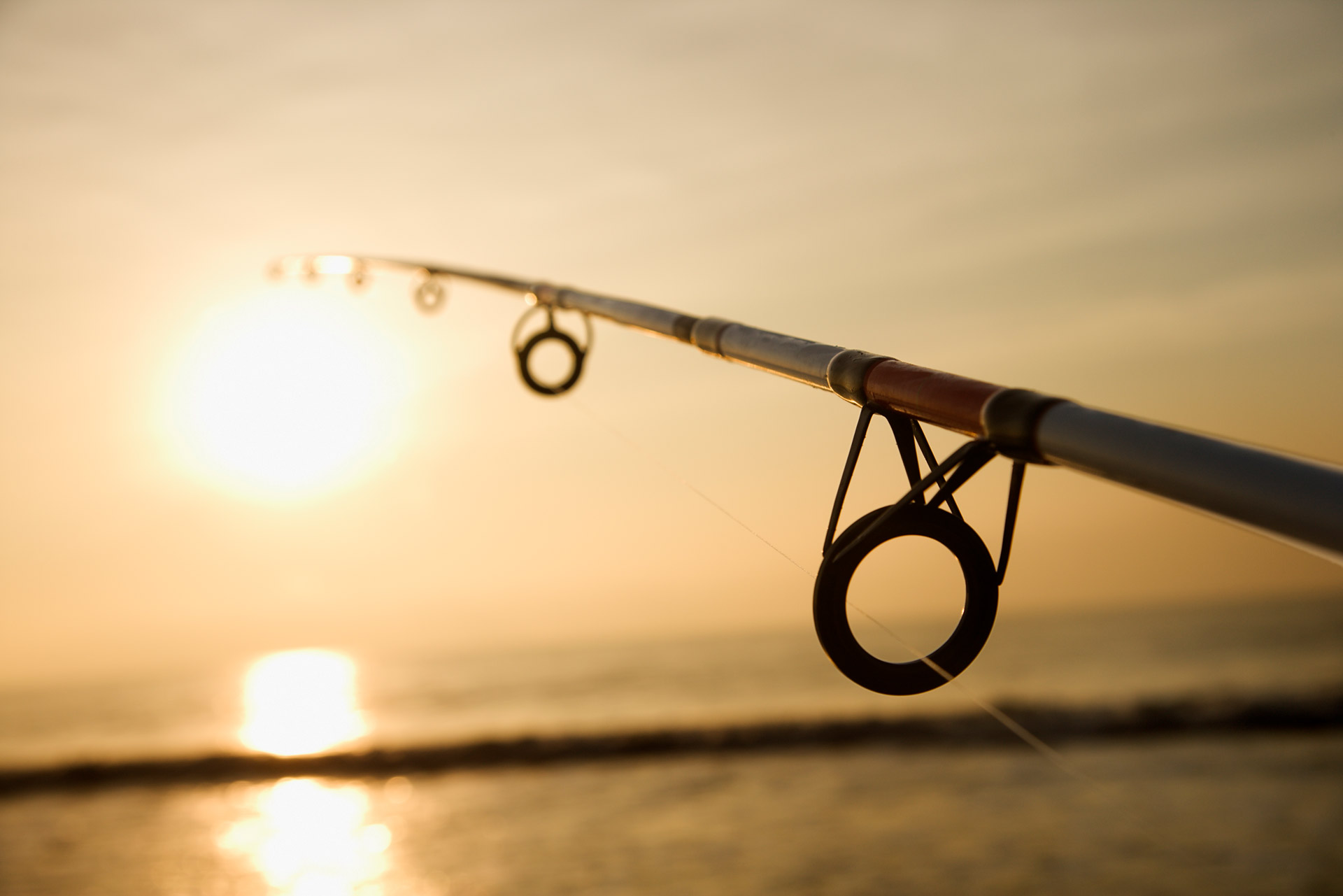Bass Vs Trout Fishing: Everything You Need To Know
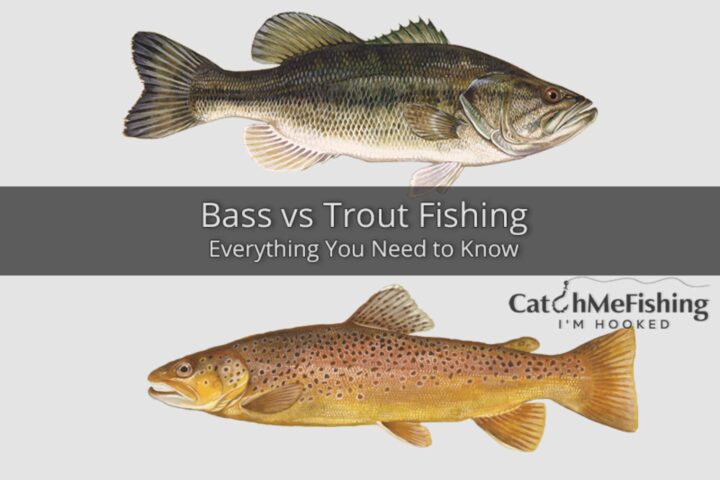
Bass and trout fishing are two popular types of angling that many people enjoy. These two fish have some similarities, but they also have a lot of differences.
I put together this article to help you better understand the differences between bass vs trout. It includes all the information you need to know about bass and trout fishing, including how they differ in size, appearance. Also, the tackle needed for bass and trout fishing techniques, and more!
Let's get right to it!
The Main Differences Between Bass and Trout
Bass and trout are different species of wild fish located in different habitats.
Trout usually live in fast-moving, clear, cold water between 33 and 68 degrees(F). In comparison, bass live in deeper lakes and rivers, which have higher temperatures between 55 -70 Degrees (F).
Trout are fussy, can be pretty hard to catch, and bass are generally less picky and can be caught easier than trout.
Bass fishing requires heavier fishing tackle and hooks, whereas trout fishing requires lighter gear and hooks.
Trout have vomerine teeth while bass have teeth on their lips that face inwards.
Here is the stand out features of trout and bass:
What is a Trout
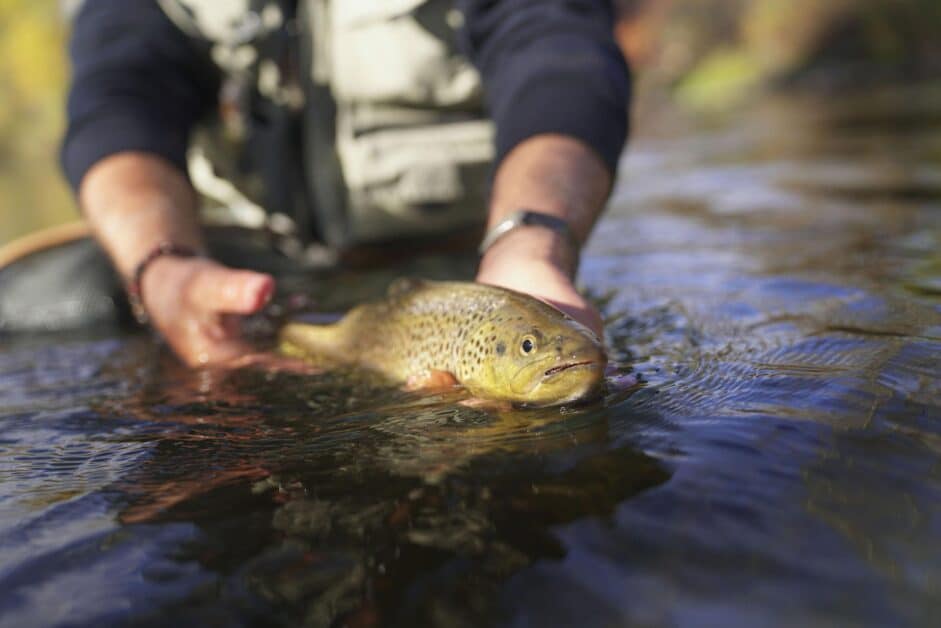
Trout is a freshwater species of fish in the same family as char and salmon.
Trout are mainly freshwater, cold-water fish. They love fast-moving cold water, which is as clear as tap water. Streams and rivers are the perfect home for trout and the perfect place to fish for them.
Unlike bass, trout tend to have much stricter regulations to preserve the stock and spawning seasons. In effect, this prevents you from trout fishing at certain times of the year.
The best time to catch trout is late spring, when they travel up the streams and rivers.
Although most trout live in freshwater rivers and streams, there are also lake trout and two trout species that can move between fresh and saltwater.
Rainbow and brown trout can migrate to the saltwater of the sea after the spawning season is over.
Upon entering the saltwater, the brown trout is called a sea trout, and the rainbow is called a steelhead.
What is a Bass
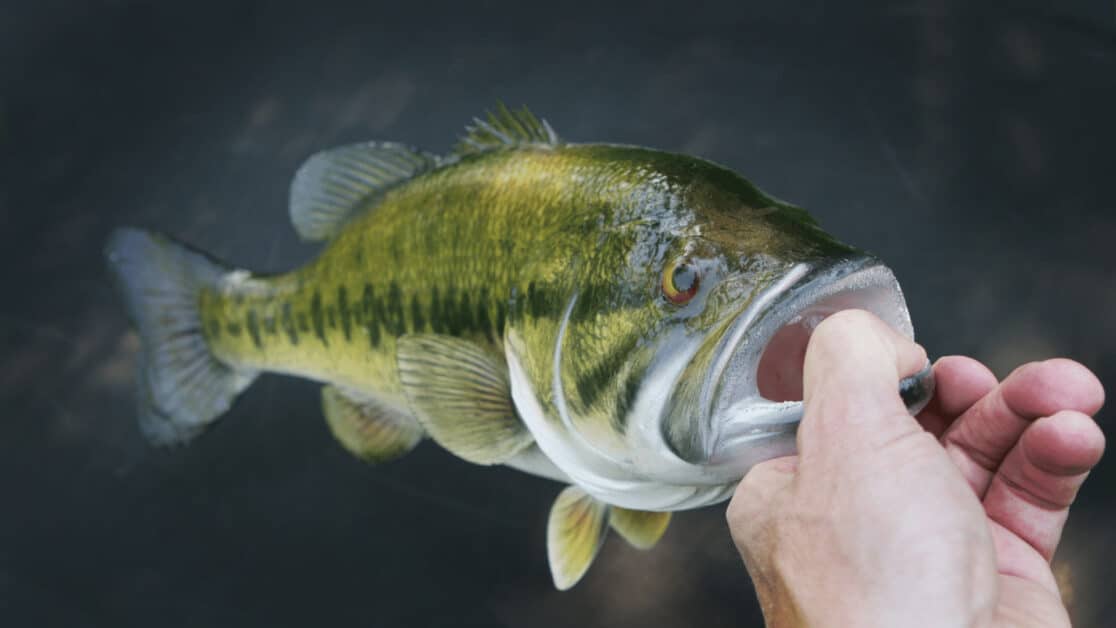
Bass are part of the sunfish family and come in a variety of different species.
While some are primarily salt-water fish, the majority live in freshwater. Thus, making bass fishing an all-year-round sport, unlike trout, which is usually only fished during special fishing times.
Popular saltwater bass includes striped bass and black sea bass.
The most popular species of freshwater bass to catch is a largemouth, or smallmouth, depending on your location in America. However, there are also spotted bass, redeye bass, and many others that you'll find as well!
The best time to fish for bass is spring and fall.
Bass can be found throughout lakes and ponds over deep water with varying temperature levels.
Unlike trout, bass can handle a broader range of temperatures and habitats, temperatures usually higher than that of trout. Although with my good winter bass fishing tips, you can still catch these predatory fish in the cold months.
How to Identify Trout vs Bass
The appearance of trout and bass is somewhat different. Most bass are broader and bigger than trout, and both bass and trout have teeth.
Popular trout species are caught in rivers, lakes, ponds, and streams.
Trout vs Bass Appearances
Trout have longer, thinner bodies than bass and have smaller, softer fins that are not as pointed.
Trout has more of a browny skin tone than bass, and unlike bass, most trout are covered all over in spots.
Different trout species differ in colors and sizes, so here are the appearances of each:
Brown Trout and Sea Trout Appearance
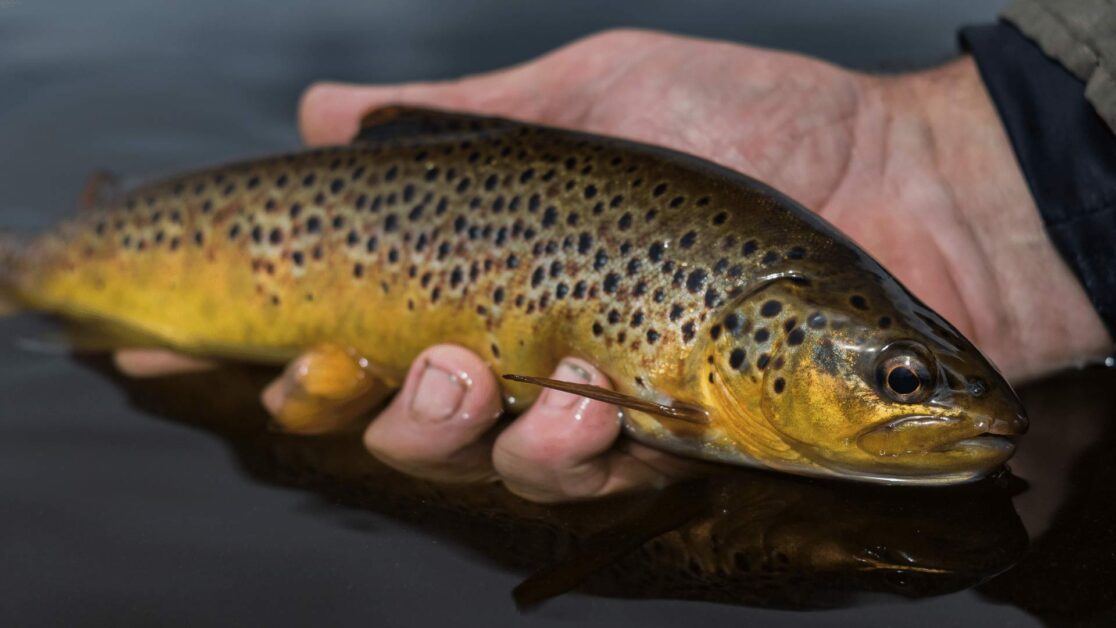
Brown trout and sea trout have the same appearances. The difference being sea trout migrate to the saltwater, and brown trout live in freshwater lakes and rivers.
Brown trout are brown and are identified by their black spots from head to tail and their yellowish-brown pale belly.
The size of brown trout ranges from 40-80cm and can weigh up to a maximum weight of 15kg.
Rainbow Trout & Steelhead Appearance
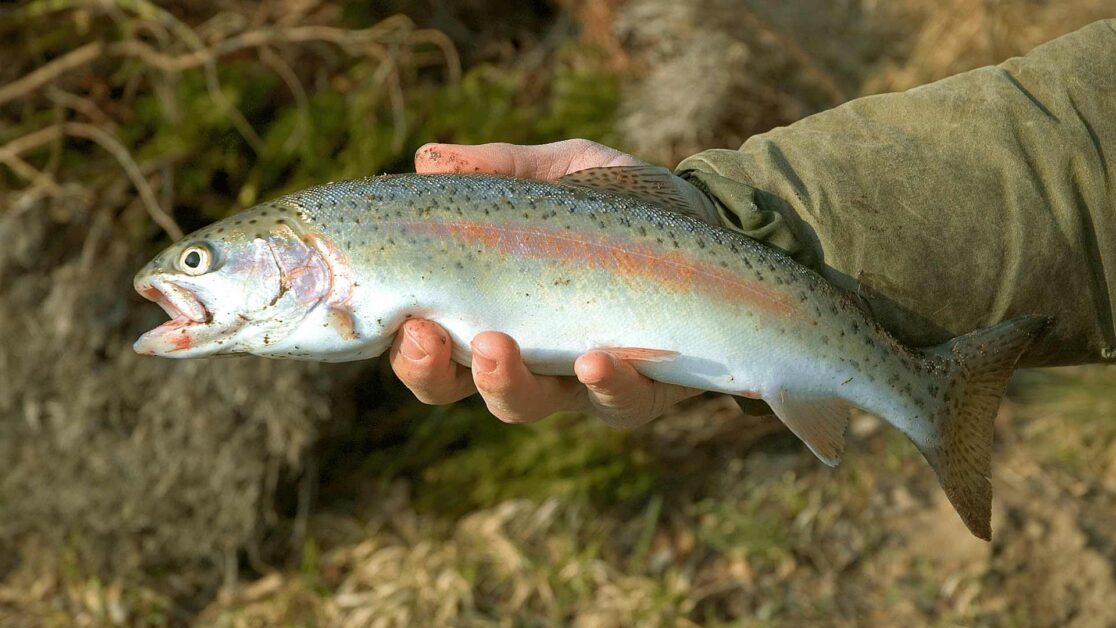
Rainbow trout and steelhead have the same appearance. The only difference between the two is one is saltwater and the other a freshwater fish. Therefore, steelhead trout belong in the sea.
Rainbow trout are long and thin, shaped similar to a torpedo. Gradients of green, yellow, and blue cover the top half of the trout's body with a long pink stripe down the sides and operculum (gill cover). The underside of the trout is white, and the top half of the body and fins are covered in brown spots.
Wild stream and river rainbow trout range from 1 to 5 pounds, depending on age. However, Lake trout can grow much bigger, up to a whopping 20 pounds.
Cutthroat Trout Appearance
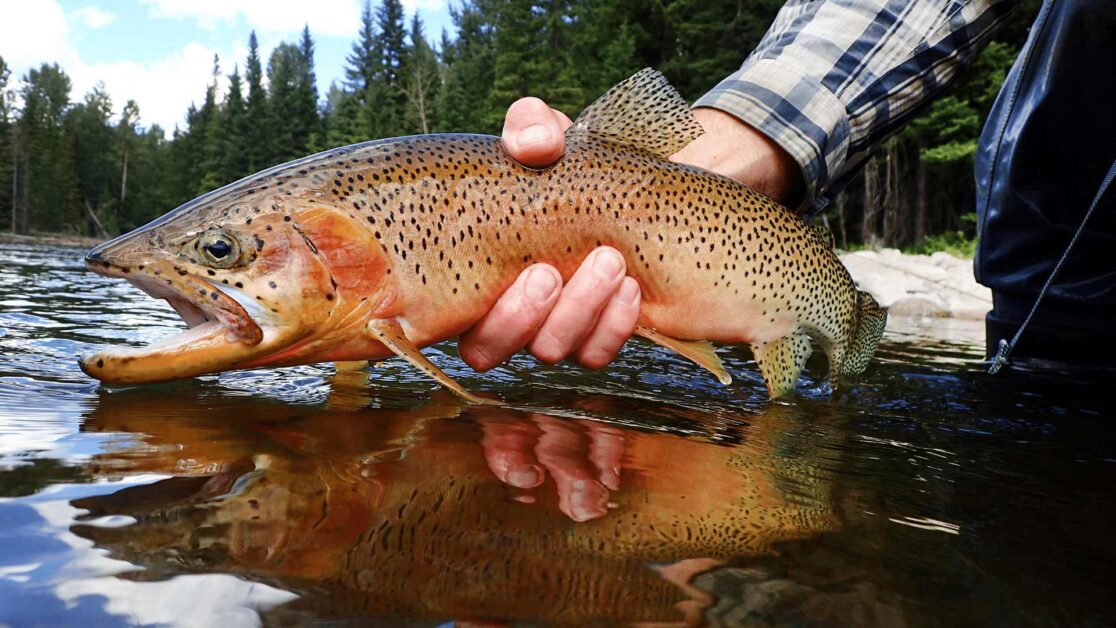
Cutthroat trout are identified by their red-orange slash that starts at the gills and extends to just under their jaw.
They have a greenish-brown or olive color on top of their back, while underneath, they are white with silver sides. Like the brown trout, they have spots all over their bodies but become more visible nearer their tail.
Cutthroat trout weight ranges from 2 to 5 lbs and from 5 to 40 inches in length. Although, the Lahontan cutthroat species in North America can grow to enormous sizes. It has a record weight of 41 pounds which was caught in 1925.
Lake Trout Appearance
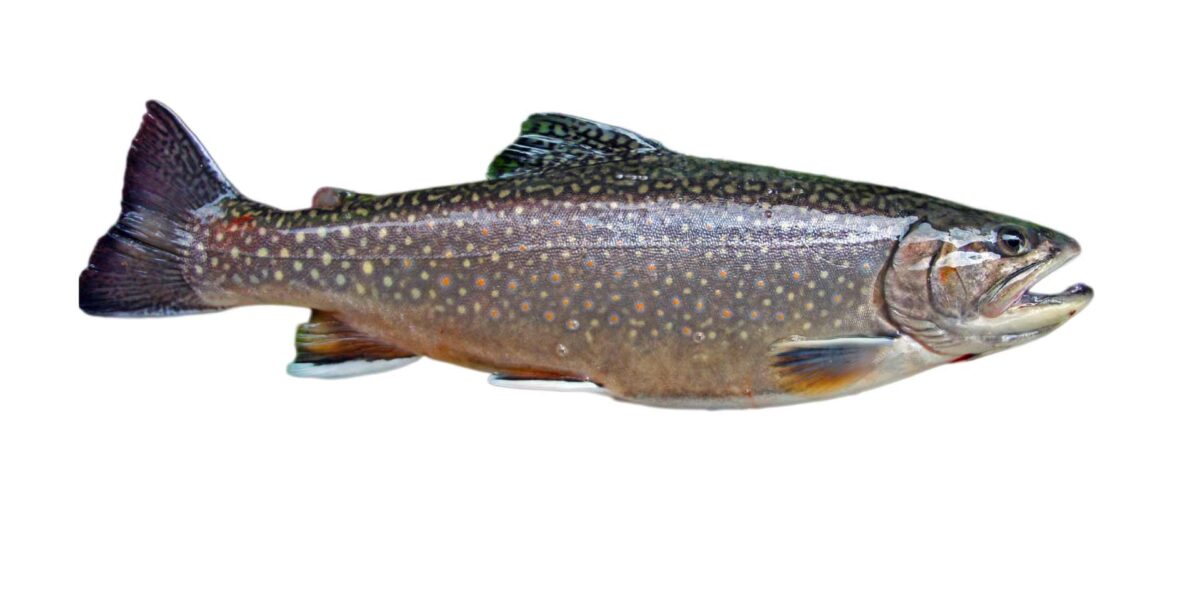
Lake trout often have a browny-olive, silverish tone and white grey on their belly. In addition, they have light-colored yellowish spots along the whole of their body.
As lake trout live in colder water, they can get much bigger than other species. Lake trout grow up to 102 pounds and up to 50 inches long. The average weight and size of lake trout are 15-40 pounds and 24-36 inches in length.
Lake Trout is the largest fish in the char family.
Brook trout appearance
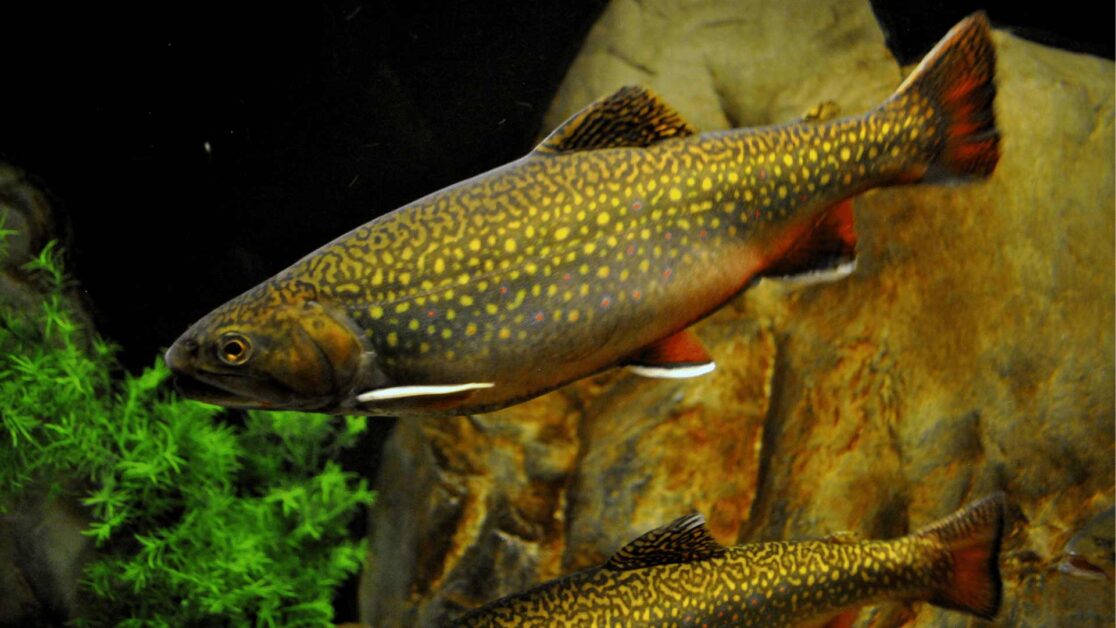
Brook trout are brown with an Orangy-reddish belly. In addition, they have pale yellow spots that cover their whole body, with a few red spots scatted between.
The average length for brook trout is 24.5 cm although, the maximum length ever recorded was 86cm.
Brook trout's average weight is between 0.5lb and 6.7lb.
Bass vs Trout Appearances
The two most common bass in North America is the largemouth and smallmouth.
Smallmouth and largemouth bass have very different physical appearances. Largemouth bass are larger in general and primarily found in lakes. In contrast, smallies are commonly found in moving rivers.
Bass are rounder than trout, have a different shaped operculum (gill cover) that's very wide at the bottom, moving towards the head. In addition, bass fins are larger and look more spikey compared to trout.
Here are the appearances of largemouth and smallmouth bass:
Largemouth Bass Appearance
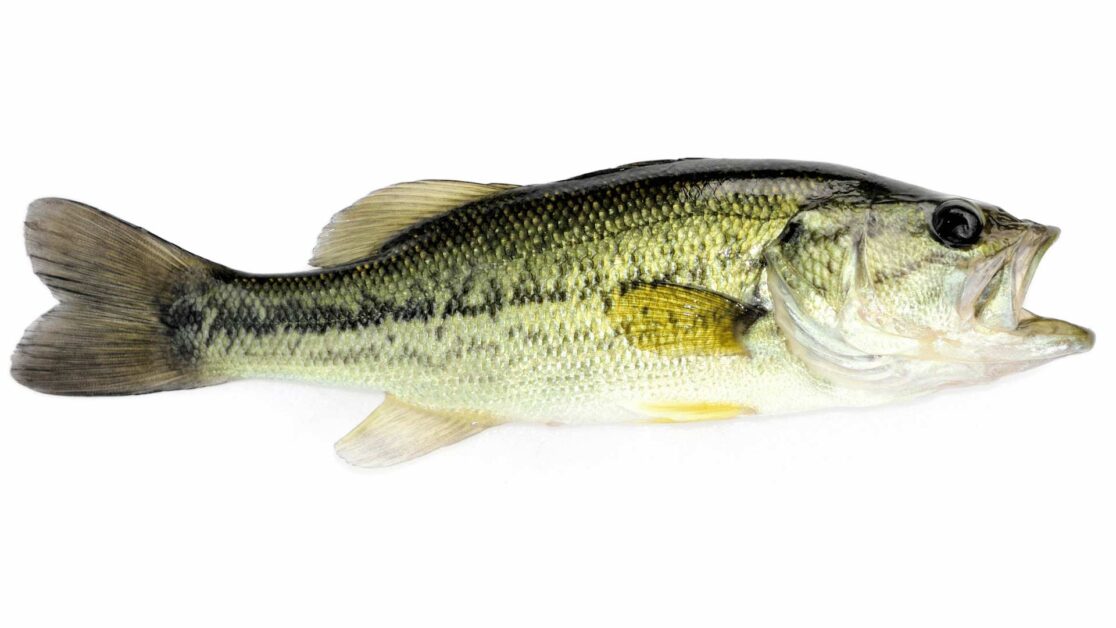
The largemouth bass is one of North America's most iconic freshwater predators, revered for its power and agility.
The green to grayish-green fish has a series of dark blotches forming a jagged horizontal stripe along each flank that extends from the gills up to their tailfin. The upper jaw (maxilla) exceeds the eye socket in length.
Largemouth bass are much chunkier than trout, with a big, deep body and a mouth that opens very wide. Much wider than that of a trout.
The average length of largemouth bass is 40cm long. However, the longest recorded largemouth bass was a record-breaking 97 cm long. Wow!
Largemouth bass weights range from 1 pound all the way up to 20lbs if it's the Florida species of bass. Anything over 5lb is considered a big largemouth bass.
Smallmouth Bass Appearance
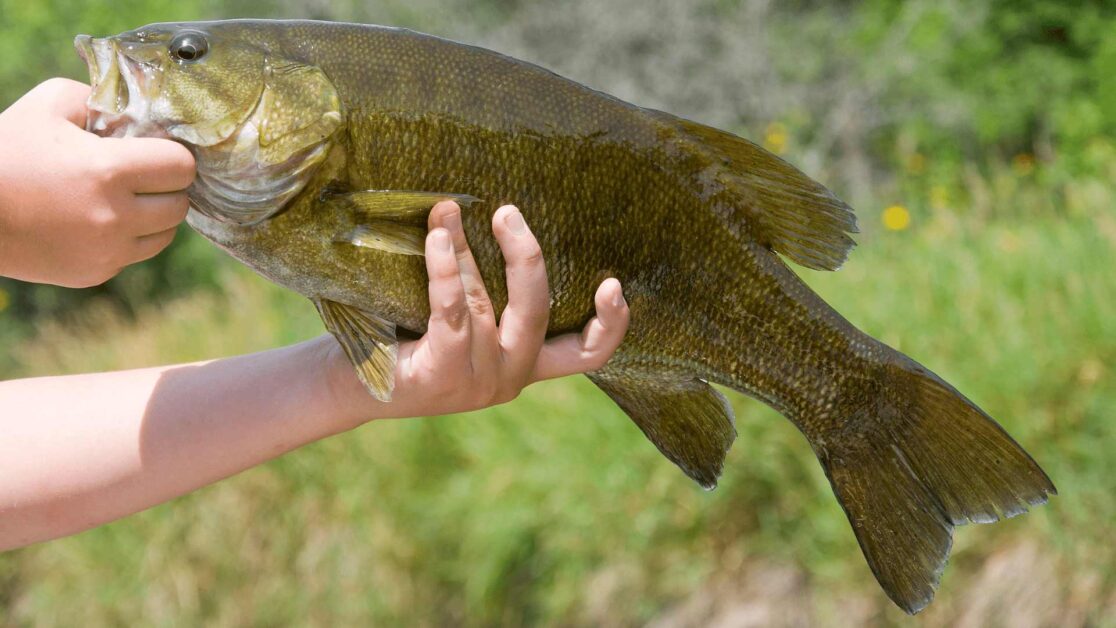
The smallmouth bass is a freshwater fish found in lakes, rivers, ponds, and streams throughout the United States.
The most distinguishing characteristic of this species is it's brownish-green, or sometimes even black scales with yellowish-white undersides along with vertical lines running down either side of their body called lateral line scale rows.
Smallmouth also exhibit distinctive brown stripes that run horizontally along their head.
Smallies measure from 12 to 16 inches long on average, but some have grown up to 27.2 inches long!
6.6lbs is the average weight of a fully grown adult smallmouth bass.
Can Bass and Trout Live Together
While it's not recommended, it is possible to mix trout and bass together in the same freshwater pond.
The temperature for both species has to be just right. It's best to add trout to a bass pond in the fall when the weather is cool enough for them to survive.
Introducing the trout will just be temporary, though. If the trout survive being eaten by the bass, then they won't last past the following year's rising heat in the summer.
Small trout make excellent food for pond bass. Introducing the trout into the pond in the fall will give the bass enough food to feed them all winter. The bass will grow substantially with the dense nutrition the trout will provide them.
Trout and Bass Size Difference
Trout are usually smaller in small rivers and streams (Lake trout make an exception to this). They usually reach up to 6 pounds, but most will be around 2 lb.
In contrast, largemouth bass can usually weigh 12 pounds with a maximum report weight of 22 pounds.
And although Bass, in general, are bigger than trout, It's still possible to catch very strong and heavy trout.
Most of the big trout are in lakes and can grow much better than bass. Although realistically, you will catch bigger bass than you would do trout.
Fishing Tackle for Bass and Trout
Bass fishing uses heavier gear and tackle than trout fishing due to catching bigger fish with larger mouths.
Trout are notorious for being pickier and more linewise than bass so choosing the right line weight, leader, and bait is crucial if you will be fishing for them.
Both bass and trout can be caught on flies and lures. Trolling and jigging can also be used to catch both types of fish.
Here is a list of gear that I use to catch trout and bass:
Bass Fishing Gear
Bass fishing requires heavier tackle than trout fishing because most bass you catch will be much larger than trout.
Bass have a habit of running into cover when you hook them. Having strong gear will ensure you will get out of snags and land the fish more easily.
I use a strong bass rod, reel, and line to help me keep control of the large, aggressive bass I catch.
Bass Fishing Lures
Always have a range of clean lures in your tackle box or backpack on every fishing trip, so you have bait for every situation you may face.
I use larger lures for largemouth bass and smaller lures for smallmouth.
Some of my favorite lures to carry with me every time I go fishing are crankbaits, spinnerbaits, topwater lures, jigs, and a variety of different spoons. Of course, I also carry many soft plastics, which I can set up with a rig.
Trout Fishing Gear
Depending on which species of trout and location you will be fishing will determine the best style of fishing you will use.
Large lakes with big lake trout will require heavier gear and lures. Much like bass uses. Trolling and jigging for these big fish require you to fish similar to largemouth bass from a boat in big lakes.
On the other hand, fishing for trout in rivers and small streams is perfect for fly fishing.
I always use a good lightweight fly rod and reel when I go fly fishing for trout.
Choose some quality flies and pick your favorite colors.
Most fly fishermen invest in a set of high-quality waders due to wading up and down the cold river water. They will keep you nice and dry and make your fishing adventure much more enjoyable.
On the other hand, you can also try trout fishing with spinning gear. To do this, you need an ultralight spinning rod and reel combination to slowly troll the water to find schools of trout. With spinning gear, you can toss the lure or live bait upstream and let the water current take your bait to the trout. To know more about this trout fishing method, check some reliable resource websites to get more information.
Trout vs Bass Fishing Techniques
There are many different techniques and styles of fishing. Trout fishing is a sport that requires patience, skill, and an appreciation for the natural beauty that surrounds you.
Fly fishing for bass has become an increasingly popular activity lately.
The art of fly-fishing is unlike any other, with the same slow and arduous process to be mastered by every angler to achieve success.
To catch trout, you want to use a lighter tackle so that the line won't scare them off with its noise or weight.
Bass fishing
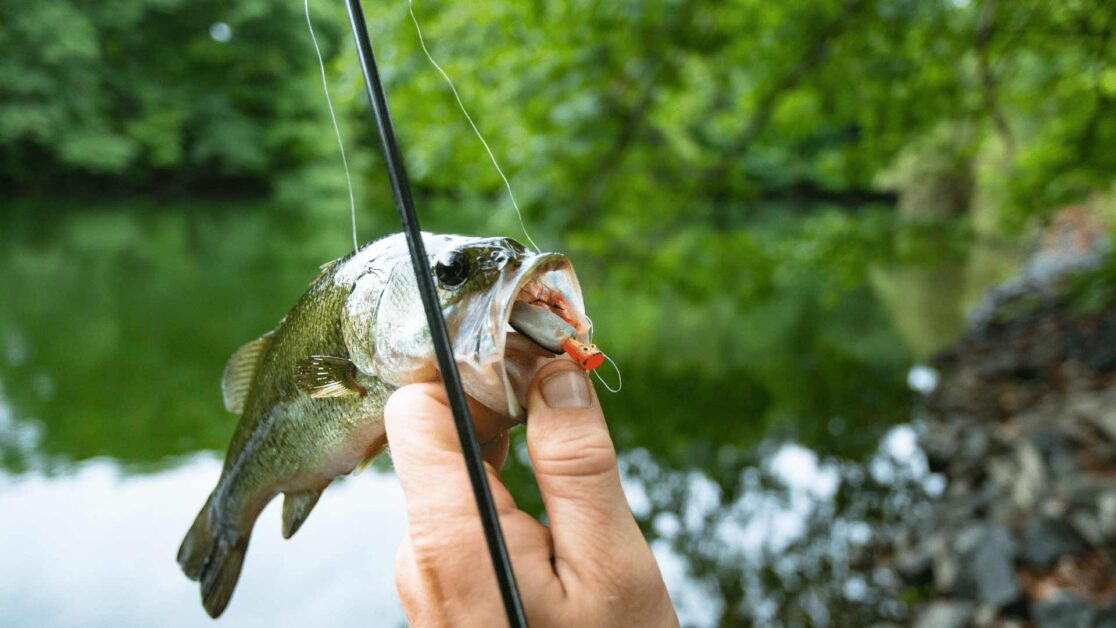
Targeting bass fishing locations is vital to success. Flipping and pitching can serve as effective bass fishing techniques.
Most Bass anglers like to fish from a boat, but you can also catch bass on foot from the shore or bank.
Bass fishing techniques are different from trout fishing because they are larger fish and have different feeding patterns.
Bass attack baits and lures with fire and aggression, so you can use heavier gear without scaring them off.
You could always try fly fishing for bass if you are already a trout angler. This is because you will already have the knowledge needed to entice the bass from the time you had learnt going after trout.
Aside from the ones mentioned above, other helpful tips can make bass fishing much easier and quicker. For instance, cast carefully toward the fish to prevent the bait from being propelled by the current.
Moreover, be patient with bass fishing as these fishes are challenging to capture. It may take some time to catch one, but with good fishing and waiting techniques, you can succeed in bass fishing.
Try to use live bait as much as possible to increase your odds of catching a bass. When bass fishing in open water, you can use crickets, jigs, and worms as bait options.
Trout fishing
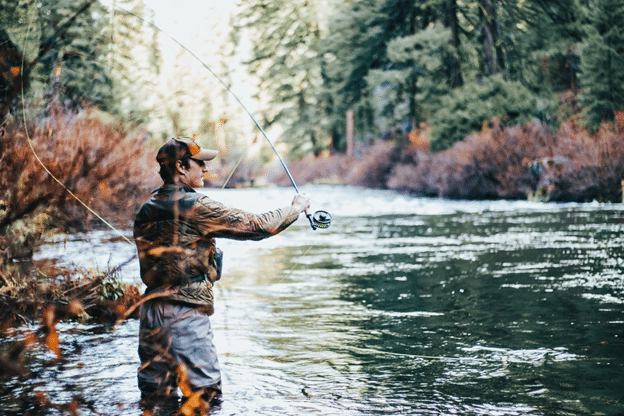
Trout fishing is typically done with flies, although you can use artificial lures.
Fly fishing is one of the oldest techniques to catch trout. With fly rods, anglers use small flies to give their prey a realistic look and trick them into thinking it's something they're interested in eating.
Patience is key when it comes down to truly mastering this sport.
There are so many variables that need consideration before even casting out your line, such as wind direction or water temperature. All factor into whether you will have a successful days fishing.
Furthermore, there are also practical tips that can make your trout fishing experience less complicated. For instance, it’s essential to find the right spot with plenty of banks and deep water so the trout can easily see your fly.
Since trout like cold water temperatures, make sure to dress appropriately when going trout fishing.
Lastly, to be successful in catching trout, it’s essential to exercise patience and keep an eye out for indicators that the fish is about to feed.
Is Bass or Trout Fishing Easier
This is a difficult question to answer because it depends on the person and their experience.
Trout fishing is a much more finesse style of fishing and requires a lot of patience. It's much harder to pick up for a beginner than bass fishing.
For an experienced trout angler, bass fishing might be out of their comfort zone.
However, for beginners who don't know what to do with a fly reel or fly rod (and it's also harder to find beginner-level fishing guides that specialize in trout), bass fishing would be the better option.
Bass is easier to catch, pound for pound, and they grow much bigger than river trout. This makes them appear more difficult, but with heavy gear, it doesn't pose a problem.
Comparing Trout to Bass Bites
Bass normally attack the lure or bait very aggressively and eat differently. Trout, on the other hand, usually are very stealthy in their approach.
Trout are more likely to play with your hook than take it.
Bass are aggressive, they love noise and often strike at the sound of a loud splash from an object falling into the water.
Some spinners and crankbaits are specifically designed for bass to create vibration and noise in the water to attract them.
The trout is not as likely to immediately take the bait or lure that's offered up, so it can be more difficult to target them.
Trout will usually be spooked by noise.
Even when trout takes your fly on the top of the water, you will likely not see any evidence or movement until your line pulls.
Bass vs Trout Fights
Bass are bigger and heavier fish than trout so generally, they put up a harder fight.
Although most bass are bigger than trout, a trout with the same weight fights harder.
Bass and trout fight very differently because of their size difference and it's unfair to say one puts up more of a fight than the other.
Bass use more strength than speed when fighting, while trout try to get away as quickly as possible using fast movement zigging around.
Trout spend most of their life traveling through fast-moving water so they are very lean and can move around very fast.
Both fish will shake their bodies and heads as they move through the water while hooked. Trying to shake your hook from their mouths.
Both fish put up a great fight and are great experiences that every angler should experience at least once.
Which Fish is More Fun to Catch
It's tough to say which is more fun. I guess that it depends on the person and their experience level.
I believe if you love fishing, then you would enjoy both fish and their styles of fishing.
Trout fishing has more of a learning curve compared to bass, so might not be quite as fun for beginners. Although, once you learn the basics it's great fun.
Both fishing experiences are great, but which is better depends on the person.
I personally love trout and bass fishing because they both offer unique challenges that make for a fun experience.
If you're deciding between the two based purely on your preference, then it's up to you!
Which Fish has the Best Taste
Many people say that trout tastes better because of its superior fat content. Trout, which is similar to salmon, has a sweeter, milder taste than bass.
This is attributed to the difference in the way their flesh is structured, and while some say it might be an acquired taste, once you get used to trout's flavor profile, there's nothing more fulfilling than eating it.
I like the taste of bass, but it's a matter of preference.
Trout live in water that is much cleaner and clearer than bass. Thus, giving the meat a much cleaner taste.
If you don't like your fish to have bones, a bass would be the better option. This is because trout have tiny bones that can be hard to remove. However, you can fillet bass, and you can remove all bones very quickly.
Both are lovely fish to eat, and it all boils down to preference. You should give both a try you won't be disappointed.
Enjoy Your Trout and Bass Fishing
If you're going out fishing for trout or bass, be sure to enjoy the experience.
If you are going fly fishing for the first time I have a great article I put together for you fly fishing for beginners.
It's an excellent opportunity to get outside and spend some time with friends and family.
Great bonding experiences are had by all who take the time to have fun together.
There are so many things that can happen when fishing, but what you should enjoy the most is that you're out there having fun with your friends and family.
I hope this post helped answer some common questions about bass vs trout while giving a little insight into what it's like to catch both of these fantastic fish.
Good luck with your fishing adventures!



